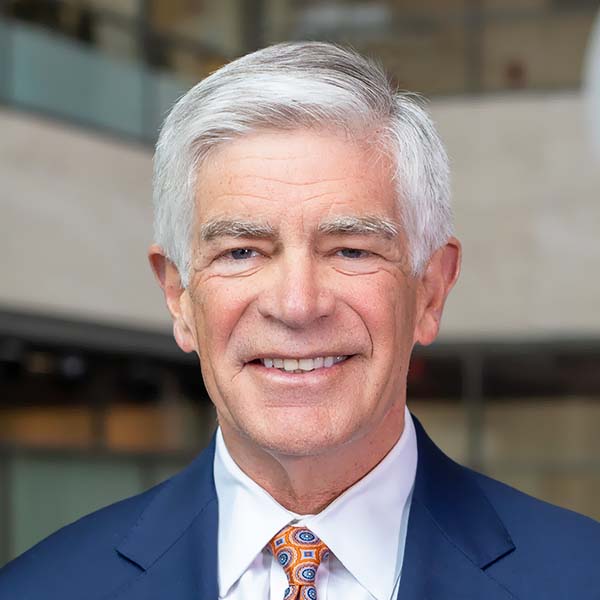Good morning, everyone, and welcome to this latest installment of what is quickly becoming not just one of the Federal Reserve Bank of Philadelphia’s premier conferences but one of the premier conferences on fintech, period.
Even though this one is a home game for me, so to speak, I still must preface my remarks with the standard Fed disclaimer: The views I express today are my own and do not necessarily reflect those of anyone else on the Federal Open Market Committee (FOMC) or in the Federal Reserve System.
Or, as I like to put it, when you are recounting my remarks, just say, “Pat said.” Don’t say, “the Fed said.”
We have a full house here at the Philadelphia Fed, and more than 1,000 others joining us virtually. While this is only slightly fewer people than Taylor Swift and Beyoncé drew to Philadelphia, it is an incredible number that speaks to much more than the expanding interest in fintech but also to the efforts of those who put this conference together.
And with that, I must give my thanks to Julapa Jagtiani who leads this effort. She is so much more than just a terrific introductory speaker. Julapa truly is the heart of this conference and a valuable source of information and contacts on a wide range of fintech topics, concerns, and approaches.
I also wish to thank our panelists and speakers, several of whom I am proud to call my colleagues within the Federal Reserve System, along with all the organizing partners of this year’s conference. This truly is a strong team.
And, of course, my thanks to each of you for joining us, whether in person or online.
Now, this is a conference to which I always look forward to attending. After all, by education, I’m an engineer even more than I am an economist. So, any forum that stands at the nexus of these two disciplines is enough to pique my interest.
As an economist, and especially as president and CEO of the Philadelphia Fed, my goal is to ensure a stable economy that provides opportunities for everyone to grow and succeed. As an engineer, and specifically as a civil engineer, my goal is to ensure a safe, reliable, and stable infrastructure, which provides opportunities for all communities to grow and succeed.
And I am far from the first person to recognize this important interdisciplinary connection. In 1917, the then-director of the College of Engineering at Northwestern University, John F. Hayford, wrote an essay in the Journal of Political Economy titled, fittingly enough, “The Relation of Engineering to Economics,” which contains the following:
Economics and engineering are closely related. Economics has been defined as the social science of earning a living. With the same appropriateness, engineering may be defined to be physical science applied to helping groups … to make a better living.1
If you drill down below the surface of this statement, it becomes clear that both economists and engineers are looking for ways to make systems stronger, more equitable, and more efficient. And we can see throughout history the advances in civil engineering which brought about both economic and societal advances.
We can chart the progress from the days of siting cities within sheltered harbors or along navigable rivers and lakes, to the digging of canals and the laying of railroad tracks, which allowed for the siting of new cities; to the advent of the automobile and the airplane, which drastically shrunk distances; to the creation of the microchip, which enabled the birth of the Internet and e-commerce; and, yes, fintech, which render one’s location almost meaningless.
Well, the same progress can be charted through our understanding and conceptualization of money. The barter system limited transactions to those in which two parties could come to agreement — I happen to have what you want at the moment you have what I want. The advent of cash, from cowry shells to paper notes, meant that anyone who held those commodities would be in equal standing with the next person holding the same, making markets run more efficiently and fairly.
But now our concept of money is changing. We no longer need to hold actual notes when electronic bank statements tell us how much is in our accounts and any number of instant payment apps on our smartphones allow us to move virtual money to practically anyone in any corner of the world, again, rendering our locations practically meaningless.
Yet, we still call a transaction made through code merely representing paper notes a cash transaction. Likewise, our e-wallets hold “credit cards” that aren’t cards at all, just graphical representations. And the development of cryptocurrencies and stablecoin is forcing us to further rethink our relationship with, and the nature and future of, cash.
These changes come in some ways for the better, and in some that should raise concerns. Everyone here recognizes that fintech presents not just opportunities but also challenges, and that we will not ultimately succeed if we only focus on the former and ignore the latter.
So, how do we view these innovations? How do we ensure adequate understanding of their risks and benefits? And how should public policy and regulation address these as they pose both benefits and risks to consumers and the economy at large?
These are just a few of the questions swirling around the topic of fintech, which bring us to today and this conference.
But the biggest question of all is not “what if” but “what next”? This is the big question that will be in the background of every conversation over these two days. And my hope is that these conversations will keep us moving toward the answer.
We are witnessing a technological revolution through AI, which holds tremendous promise for increasing productivity and allowing for more decisions to be made in real time.
As an increasing number of institutions turn to AI-powered chatbots, the need for us to continue fine-tuning and securing this technology only increases. A recent story2 in the New York Times highlighted a Las Vegas conference at which white-hat hackers were asked to help uncover vulnerabilities in the safeguards of AI chatbots. And many found ways to trick these chatbots into making misleading, unethical, and potentially dangerous statements.
It’s not hard to move from this situation to one of malicious hackers exposing security flaws to exploit unsuspecting customers at a financial institution into giving up sensitive identifying information. This is an instance where our ability to keep focused on what may be next will also ensure consumer confidence.
And we at the Federal Reserve, both here in Philadelphia and System-wide, are going to remain focused on doing our part. For example, July saw the rollout of the new FedNow instant payment service platform. With FedNow, we will have a more nimble and responsive banking system. Within the Third District, we continue working with our banking partners to encourage their participation.
Certainly, the Federal Reserve is not first past the post in creating an instant payment system — other systems, whether operated by individual banks or through third parties, have been operational for some time. But by allowing banks to interact with each other to ensure one customer’s payment quickly and efficiently becomes another’s deposit, the Federal Reserve is fulfilling its role to provide a fair and equitable payment system.
Another area where the Fed is providing thought leadership is in quantum computing, or QC. And I am especially proud that this System-wide effort is being led from right here at the Philadelphia Fed.
Quantum computing has the potential to revolutionize security and problem-solving methodologies throughout the banking and financial services industry. Right now, individual institutions and other central banks globally are expanding their own research into QC. And just as these institutions look to the Fed for economic leadership, so, too, are they looking to us for technological leadership.
QC holds tremendous promise for expanding capabilities far beyond those that our current systems allow. But we also know QC could allow for nefarious actors to pose a truly global cybersecurity threat — such as by hacking encryption algorithms. And while there is noted progress in quantum-resilient encryption, as a banking regulator, ever-present technological change means we cannot take our eyes off the ball.
These examples are why the Fed will also continue its efforts to provide leadership in the areas of financial literacy and education — including the publications and materials we have made available for educators to take into their classrooms — to give consumers the tools they will need to navigate these new waters, make smart decisions, and protect their own futures.
Thankfully, we are not alone in any of these efforts. Throughout the financial system are numerous partners — public and private sector alike, inside this room and watching online — who understand the importance of making sure we get the correct answer to the question, “what next?”
And, as it just so happens, one of these partners is the subject of our first Fireside Chat — Rohit Chopra, director of the Consumer Financial Protection Bureau (CFPB).
Throughout his tenure leading the CFPB, and before it as a member of the Federal Trade Commission, Director Chopra has focused on issues of fraud prevention and economic and financial fairness.
I am also honored to welcome him as he happens to be an alum of the Wharton School of the University of Pennsylvania, which is not only one of our conference’s organizing partners, but where I also hung my hat as dean for many years in my prior life in academia.
And leading the discussion will be the director of the Digital Assets Policy Project at Harvard University’s Kennedy School of Government, Tim Massad.
In addition to authoring numerous articles on crypto and financial regulation, Tim served as chairman of the U.S. Commodity Futures Trading Commission — a tenure that brought him front and center with numerous fintech issues — and as assistant secretary for Financial Stability at the United States Treasury.
With that, it’s time to get this seventh Fintech Conference formally started.
So, what next?
Well, at this microphone, it’s the director of the Consumer Financial Protection Bureau, Rohit Chopra.
- The views expressed here are solely those of the authors and do not necessarily reflect the views of the Federal Reserve Bank of Philadelphia or the Federal Reserve System.
- Hayford, John F. “The Relation of Engineering to Economics,” Journal of Political Economy 25:1 (1917).
- Sarah Kessler and Tiffany Hsu, “When Hackers Descended to Test A.I., They Found Flaws Aplenty,” New York Times, August 16, 2023.

